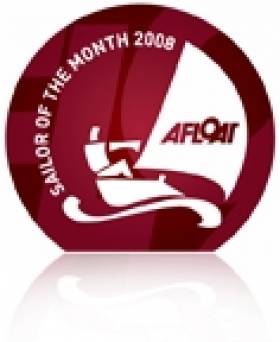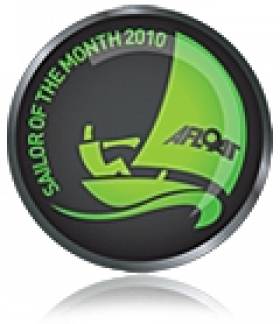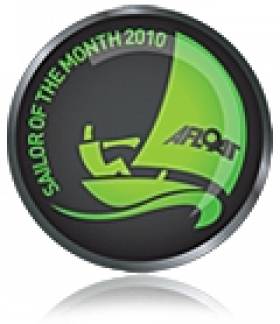Displaying items by tag: sailor of the year
George Kenefick is Sailor of the Year
#SAILOR OF THE YEAR – George Kenefick of Cork is the new Afloat.ie/Irish Independent "Sailor of the Year" after an exceptionally diverse and successful season in which the 23-year-old Crosshaven skipper logged major successes at a wide variety of venues in an almost bewildering array of boat types.
When the international sailing season started, the focus was on Keneficks's campaigns with his family's little Quarter Tonner Tiger. But by the time he became "Sailor of the Month" in October, it was in honour of achievements as diverse as helming the 2012 Half Ton World Champion, and winning the Helmsman's Championship.
It might be over-stating it to assert that his 2011 record with Tiger ranked among the least of his year's achievements. After all, he did win the class in the ICRA Nationals 2011 at Crosshaven in June with six firsts and one second. But at the Sovereigns Cup in Kinsale which was staged a few days later, he seemed to have lost his mojo – Tiger was off the pace, even if they did finish in the top three.
Next up was the Quarter Ton Worlds in the Solent. It was serious business. So many boats carried at least one professional that a division for Corinthians was created. That was won by Kenefick, but as Tiger had been in contention in many races, we had dared to hope he might win overall.
However, while there he was recruited to helm a boat for an English owner in the Half Ton Worlds, due at the same venue in late August. It was a case of being dropped in at the deep end with a crew initially of strangers, and a huge fleet. But Kenefick kept his cool and there was no need to avail of any Corinthian clause – he won overall, first time an Irish helm has done so since Harold Cudmore in 1976.

George Kenefick and his Royal Cork crew in winning form. Photo: Bob Bateman
Then came the all-Ireland championship on Lough Derg, racing the SailFleet J/80s. He scraped through to win by a whisker. But a win is a win, and it should be remembered that for much of 2011, Kenefick's sporting energies were taken up with his position as Chairman of the Irish University Sailing Association. He is much in demand to coach youngsters training in Optimist dinghies at Crosshaven, where his father Neil introduced him to skippering at the age of three by letting him out in an Optimist at the end of a very long rope.
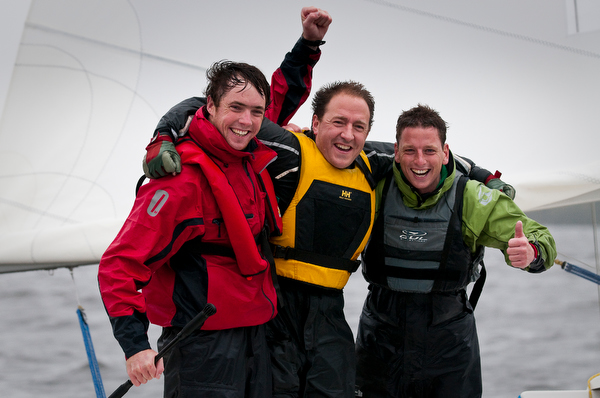
George celebrates the all Ireland win with crew men Mel Collins and John Downey. Photo: Brendan Fogarty
In this case, it has worked very well. At the end of October, Kenefick rallied his crew yet again to take the Cork team as Ireland's representatives to the Student Yachting Worlds in south Brittany. The only preparation they couldn't plan against was a draw for the boats – they were one of four international teams assigned to boats that were well past their sell-by date. Despite that, they tuned it to the utter most and gave it their very best, getting the Bronze Medal in this increasingly important event against a global lineup.
In all, a great year for George Kenefick. And good for Irish sailing too, as he has shown what can be done with the right attitude even if we are all in the midst of financial cutbacks.
Early Poll Shows Kenefick Leads in Sailor of the Year Vote
Quarter ton sailor and All Ireland Sailing Champion George Kenefick has established an early lead in the readers poll for the 2011 Sailor of the Year Award. The Crosshaven helmsman has 81 votes so far, nearly triple that of the December Sailor of the Month winner, speed sailing champion Noelle Doran of Mayo.
12 monthly winners representing the very best achievements in Irish sailing are in the line up for the overall award. Sailor of the Year Judges will decide the winner on February 18th.
The readers poll via facebook opened last week and early voting shows 2012 Olympic sailor Annalise Murphy in third place with 14 votes to date. Behind her are Olympic team mates Peter O'Leary and David Burrows.
Comments on Afloat's Facebook page accompanied the voting to include:
"Has to be Annalise. No disrespect to the others who achieved great results, but Annalise is truly world class in an elite international one design fleet with Peter and David a very close second!" Dave Quinn.
Fastest woman on the planet...Noelle Doran' Warren McCreery
'Noelle all the way' Liam Hyland
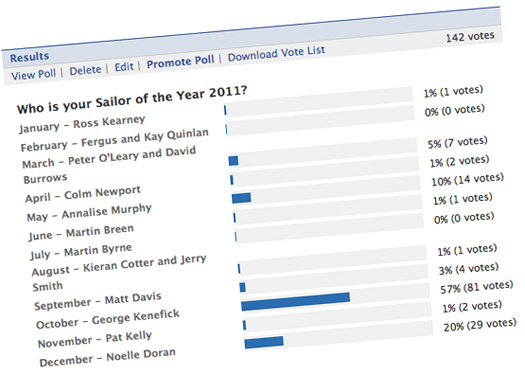
To vote or add your comment click here. Voting continues until February 18th.
Mark Mills is Sailor of the Year 2009
Celebrating a designer as a top sailor may seem unusual, but even in today’s specialized world a successful sailor is capable of many tasks afloat. And equally, a successful designer must be a high achieving sailor in the first place in order to meet the hugely varying demands of his profession. Over the years, designers such as America’s Cup legend Nat Herreshoff have shown themselves well able afloat. Olin Stephens made his name by winning the Fastnet Race twice as helm and crew on boats of his own design, Ron Holland made his mark skippering his own boat to win the Quarter Ton Worlds in 1973, Doug Peterson likewise sailed to world standard, and Rob Humphreys began his design career with wins from his home port of Pwllheli on the Welsh coast.
When we made Mark Mills Sailor of the Month a year ago, it was in celebration of his success during 2008 – mostly with Cork owners – in boats which included Eamonn Rohan’s Blondie, first out of the mould of the Argentine-built Mills-designed King 40 production class.
The King 40 began to win in many events internationally, and in October 2008, it became Boat of the Year at the big exhibition in the US, the Annapolis Boat Show. Demand was such that production was moved to America, where a smaller sister, the Summit 35, was already being developed. The King 40 became the Summit 40, and success continued worldwide. Meanwhile the 2009 season was leaping to life, and Mills designs were hitting the headlines, most notably in Ireland where Dave Dwyer’s Mills 39 marinerscove.ie continued her successful progress, while visiting King 40s lifted class titles in the Volvo Dun Laoghaire Regatta and the Sovereign’s Cup at Kinsale.
However, there was only one Mills entry in the Fastnet Race, a DK 46 of 2003 vintage, so the lack of a serious challenge in that iconic event prompted suggestions that Mills boats were extreme racing machines in which crews were unwilling to campaign flat out in true offshore conditions. That was triumphantly refuted in the 620-mile Middle Sea Race out of Malta in November. The superb Mills-designed 68-footer Alegre (Andy Soreano) won overall in rugged conditions, beating the Fastnet winner Ran (a 72-footer) on a boat-for-boat basis.
It was a magnificent achievement, but the Mark Mills success wave was progressing on other fronts. The new Summit 35 became Boat of the Show at Newport in the US, while Kings 40s and Summit 40s were winning all over the world, the Summit 40 showing her quality by launching into 2010 with another win at January’s Key West Regatta.
Mark Mills goes all over the world to meet builders and owners and take in regattas and major races. But his base is in Wicklow – in the northwest of the county where the hills are beginning to become the Wicklow Mountains. In addition to his proven racing range, current projects include a 90-metre sloop, which will have a mast-top above the usual cloud base. In all, it’s a body of work of exceptional quality. Only a very able sailor could create the ideas, and see them through to completion, and Mark Mills is most deservedly our new Sailor of the Year.
Who will be Irish Sailor of the Year 2010?
At home and abroad, Irish sailors once again delivered an impressive range of results in 2010.
Click on the month to the left to review our top sailors by month. And vote for them in our online poll (left)
As in previous years, Afloat magazine is asking the public to decide who should be crowned Ireland’s Sailor of the Year for 2010.
The overall national award will be presented to the person who, in the judge’s opinion, achieved the most notable results in, or made the most significant contribution to, watersports during 2010. Now you can log on to Afloat.ie and help select the shortlist from the last 12 months’ top performers by clicking on your sailor in the left hand column of the home page. The boating public gets to nominate their top three through the online poll, Afloat.ie gets a vote too and the Sailor of the Year judges decide the final winner.
Cast your vote by midnight February 18, 2011. The awards are administered and judged by Afloat magazine, the Irish Independent and the Irish Sailing Association.
The judges decision is final and no correspondence will be entered into.
Thanks for your interest!

Dragon Sailor Martin Byrne is July's Sailor of the Month
Martin Byrne of Dun Laoghaire is the Afloat.ie/Irish Independent "Sailor of the Month" for July with his convincing victory in the Irish Dragon Championship on Belfast Lough, a four-day event of first class racing which concluded on Sunday July 25th at Cultra.
Like so many sailing happenings which are proving successful in these stringent times, there was a distinct blast of the past about the Open Nationals 2010. The Royal North of Ireland YC at Cultra was once the leading club in the country for Dragon racing. But the creation of marinas serving Belfast Lough at Carrickfergus and Bangor meant that the pleasant waterfront club in a leafy suburb of Holywood seemed to be left behind in sailing development.
Yet the sailing waters are still there, and the people are still there too. It was local resident Simon Brien, a leading Dragon racer in Ireland and abroad, who led the movement to bring the class back to Cultra. As he has been Irish champion more than once in his 16 years in the class, Dragon sailors at home and overseas took notice. With Belfast Harbour Commission as lead sponsors, the visiting boats were craned into Belfast Docks, and the fleet of 18 top Dragons made a race of it over the four miles to Cultra where they lay out on moorings, just like the good old days.
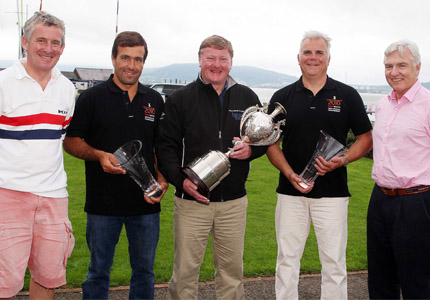
Martin Byrne, centre with trophy at the Dragon Nationals prizegiving
Crewed by longtime shipmate Adam Winklemann, and Portuguese sailmaker Pedro Andrade, Martin Byrne sailing Jaguar put his stamp on the racing from the start. In fact, the Dublin Bay boats were making hay, as Don O'Donoghue (also of Glandore) finished second overall, with Andrew Craig third. The level of racing is indicated by Klaus Diederichs, crewed by the formidable lineup of Andy Beadsworth and Jamie Lea, being back in fourth, while Simon Brien himself was in fifth, though he and his team of David Gomes and David Good took the prize for top totally amateur crew.
It was good to see the Dragons back in force where they mean a lot to sailing heritage. And it was in an area getting used to sporting success – Rory McIlroy's place is just up the road. But for now in sailing, Martin Byrne is ahead of the pack.
Mills Designs to the Fore in Commodore's Cup
Yacht designer Mark Mills of Wicklow, the Irish Sailor of the Year, will be represented by at least five sailing designs on three different teams at the next Commodores Cup to be held off Cowes in August. It will be of interest for ICRA members to know that with some teams still being finalized, the tally so far includes the custom IRC 39 Mariners Cove in the Ireland team, Hong Kong returning with the Summit 40 Blondie and the custom 40 Mandrake II (ex Ngoni), and the South Africans joining the event with the Landmark 43 Windpower and the Summit 40 Tokoloshe.





























